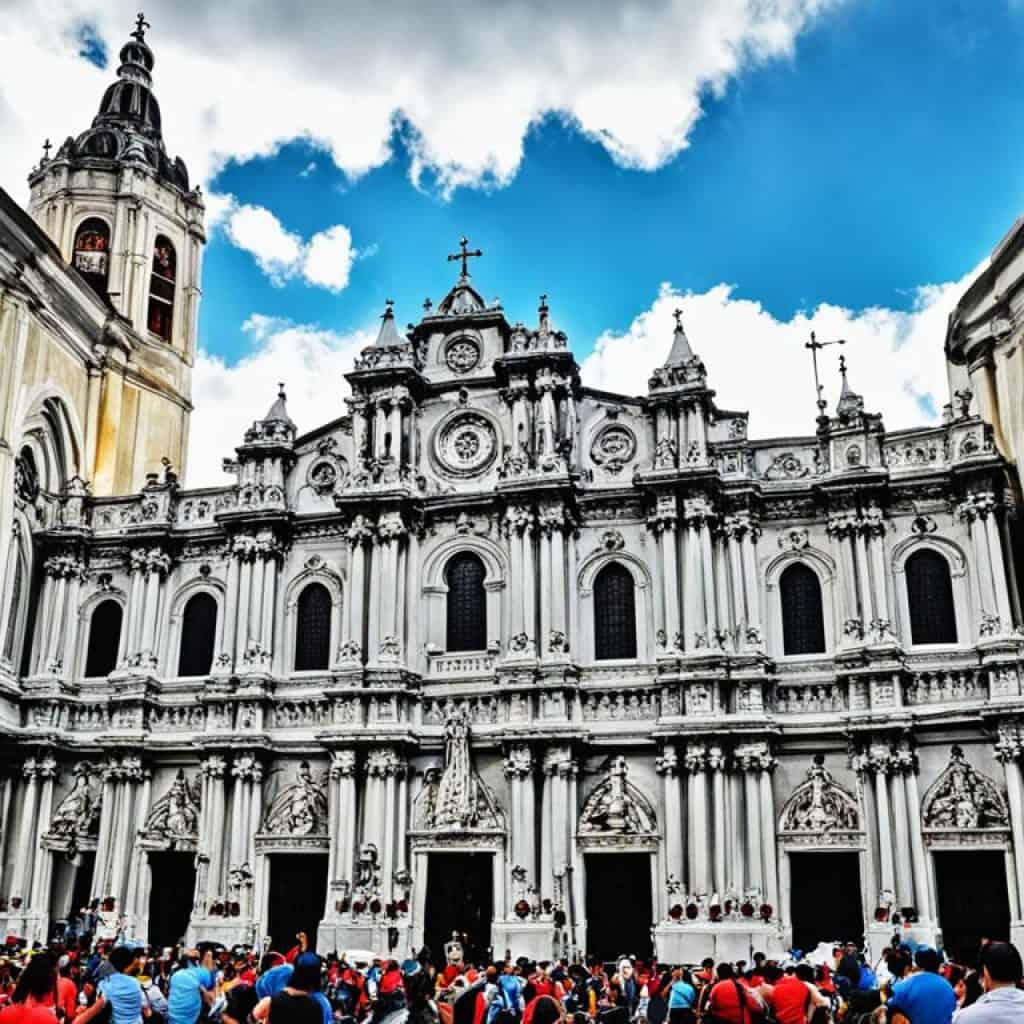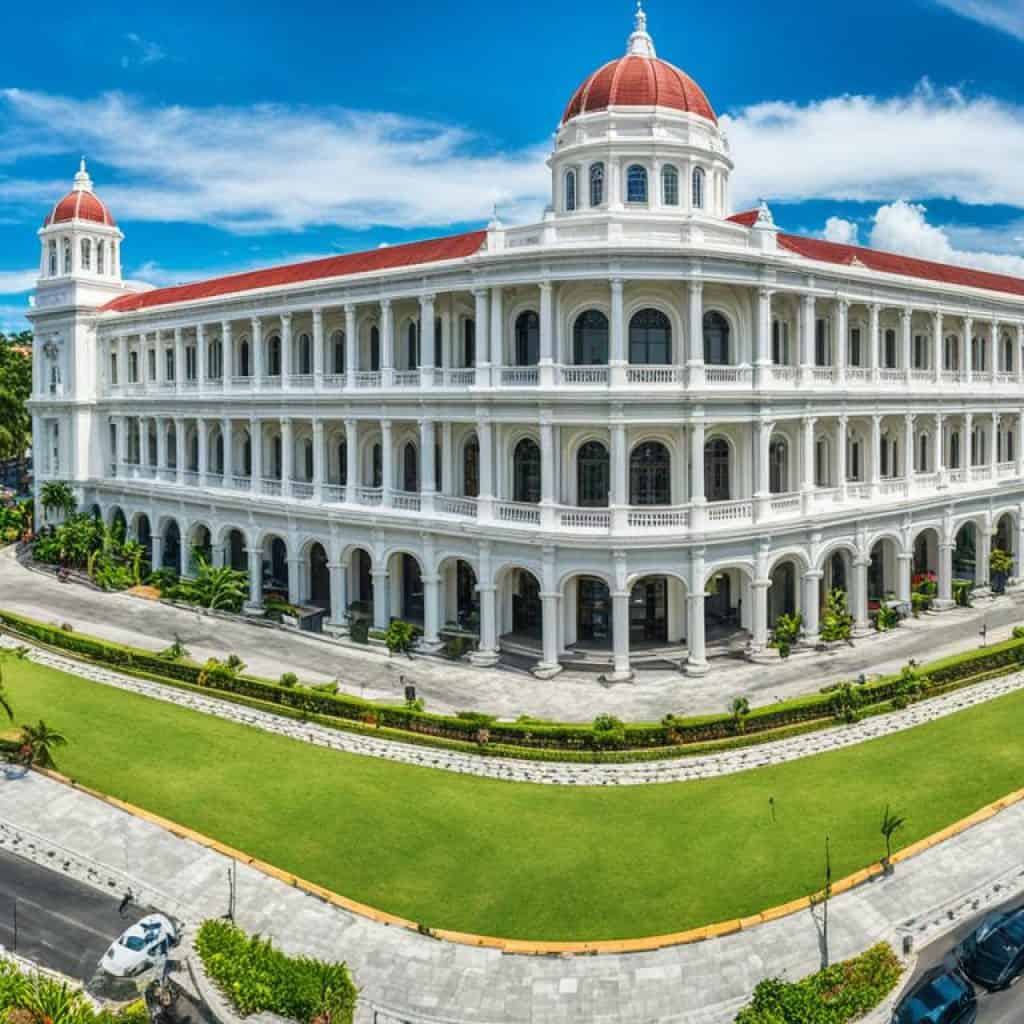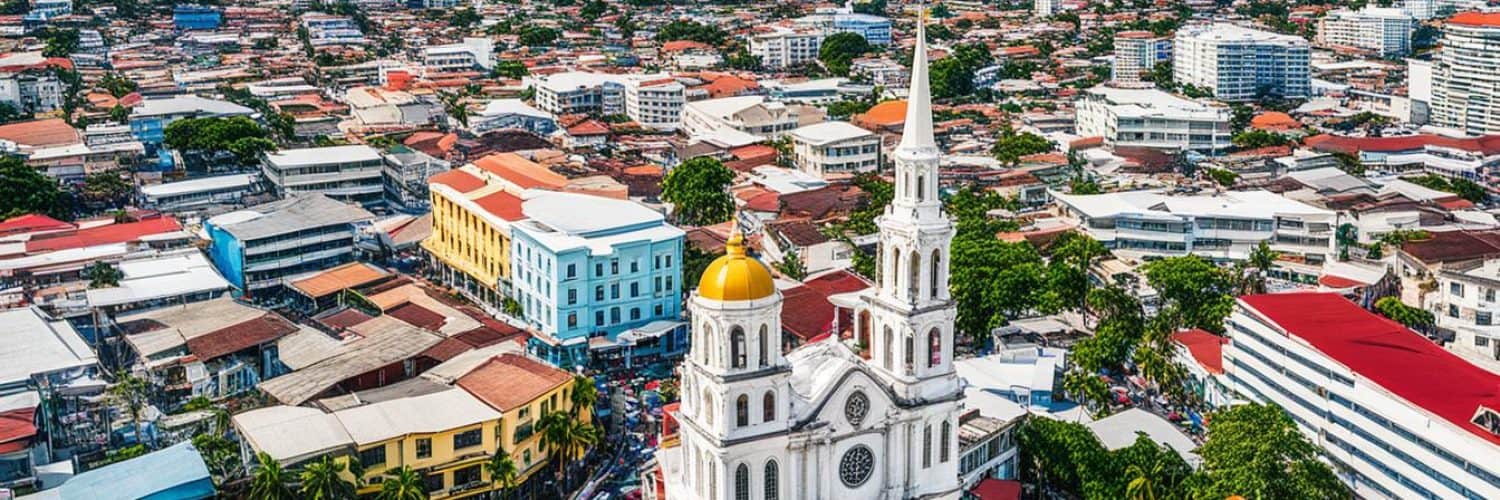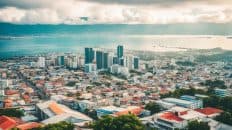Did you know that Cebu City, located in the beautiful Philippines, holds the title of being the oldest city in the country? This vibrant city has a rich history that has seen the rise and fall of empires, the colonization by the Spanish and the Americans, and the evolution of a diverse cultural heritage. From its humble beginnings to its present-day hustle and bustle, Cebu City has fascinating stories to tell.
So, how did this historic city come to be? What were the important events that shaped its history? Who are the noteworthy figures that left their mark on Cebu City? And what are the iconic landmarks that tell the tale of its past?
In this article, we’ll take you on a journey through time, exploring the historical background of Cebu City, discovering its important events and figures, and uncovering the cultural heritage that makes it truly unique. We’ll delve into the chronological timeline of Cebu City, visit its historical landmarks, and trace its evolution from its origin to the present day.
Key Takeaways:
- Cebu City is the oldest city in the Philippines, with a rich history dating back centuries.
- It has been colonized by both the Spanish and the Americans, leaving a lasting impact on its cultural heritage.
- Important events, such as the arrival of Ferdinand Magellan and the resistance against Spanish colonization, shaped Cebu City’s history.
- The city is home to numerous historical landmarks that serve as a testament to its past.
- Exploring Cebu City’s history offers a deep appreciation for its vibrant past and the enduring spirit of the Filipino people.
Visit the Heritage of Cebu Monument
When it comes to exploring Cebu City’s rich history and cultural heritage, a visit to the Heritage of Cebu Monument is an absolute must. This iconic monument serves as a captivating tribute to the significant events and historical figures that have shaped the city’s past.
The Heritage of Cebu Monument stands proudly at Parian Plaza, right in the heart of Cebu City. It is a work of art crafted by the renowned Filipino artist Eduardo Castillo, depicting scenes that date back to the 16th century.
One of the most prominent features of the monument is the representation of the Battle of Mactan, where Lapu-Lapu, a native chieftain, successfully defended the island against the Portuguese explorer Ferdinand Magellan. This event holds great significance as it showcases the bravery and resilience of the Filipino people.
Aside from the Battle of Mactan, the monument also portrays the historical moment when Rajah Humabon, the local ruler at the time, and his people converted to Christianity. This pivotal moment marked the beginning of Christianity in the Philippines and the subsequent arrival of the Spanish colonizers.
The Heritage of Cebu Monument serves as a powerful reminder of the city’s roots and the remarkable stories of Lapu-Lapu, Ferdinand Magellan, and Rajah Humabon. It symbolizes the cultural melding that occurred during Cebu’s early history and the subsequent impact it had on the Filipino identity.
Another significant element of the monument is the representation of the Sto. Niño, the revered image of the child Jesus. The veneration of the Sto. Niño is deeply ingrained in the religious and cultural traditions of the Filipino people, making it an integral part of Cebu City’s heritage.
Visitors to the Heritage of Cebu Monument can admire the intricate details and artistic craftsmanship that went into its creation. It serves as a beautiful reminder of the city’s historical journey and the diversity of its cultural influences.
Historical Significance
The Heritage of Cebu Monument stands as a testament to the resilience and enduring spirit of the Filipino people. It encapsulates pivotal moments in Cebu’s history and pays homage to the remarkable individuals who played integral roles in shaping the city’s heritage.
This magnificent monument is not only a visual marvel but also a powerful symbol of unity, faith, and cultural pride. It serves as a powerful reminder of the importance of preserving and celebrating the rich history of Cebu City.
Step into the Sandiego-Yap Ancestral House
In the heart of Cebu City stands the magnificent Sandiego-Yap Ancestral House, a true testament to the rich history of the Philippines. Built in the 1600s by Chinese merchants, this house is one of the oldest in the entire country. Despite the passage of time and numerous earthquakes, the Sandiego-Yap Ancestral House has been lovingly preserved, allowing visitors to step back in time and immerse themselves in the captivating stories of the past.
As you enter the Sandiego-Yap Ancestral House, you’ll find yourself surrounded by a treasure trove of historical artifacts and architectural marvels. The house features intricate woodwork and beautiful antique furniture, offering a glimpse into the elegance and craftsmanship of the past. Each room tells a story, providing a unique insight into the lifestyle of the Chinese merchants who once called this place home.
“The Sandiego-Yap Ancestral House is a living testament to the rich multicultural heritage of Cebu City. It stands as a proud reminder of the city’s historical ties to the Chinese community and their significant contributions to its development.” – Local Historian
One of the standout features of the Sandiego-Yap Ancestral House is its resilience in the face of earthquakes. Cebu City has experienced numerous seismic events throughout its history, yet this ancestral house has stood tall and sturdy through it all. The construction techniques employed by the Chinese merchants have proven to be remarkably effective in ensuring the stability and durability of the structure.
To enhance your visit, take a guided tour of the Sandiego-Yap Ancestral House, where knowledgeable guides will regale you with captivating stories and fascinating anecdotes that will transport you back in time. Learn about the daily lives of the residents, their customs, and traditions, and gain a deeper understanding of Cebu City’s multicultural heritage.
Visiting the Sandiego-Yap Ancestral House provides a truly immersive experience, allowing you to connect with the past and gain a greater appreciation for the historical significance of this remarkable dwelling. Whether you’re a history enthusiast, a cultural explorer, or simply someone seeking a unique and enriching experience, the Sandiego-Yap Ancestral House should not be missed.
Key Information
| Location | Cebu City, Philippines |
|---|---|
| Year Built | 1600s |
| Architectural Style | Chinese-Filipino |
| Significance | One of the oldest houses in the Philippines |
| Highlights |
|
Explore Fort San Pedro
Fort San Pedro, constructed in the 1500s by Miguel López de Legazpi, stands as one of the oldest and most iconic triangular forts in the Philippines. Initially built to protect against pirate attacks, this historic structure later played a pivotal role in the resistance against Spanish colonization.
The fort, strategically located near the coast in Cebu City, offers visitors a fascinating glimpse into the past. Stepping through its imposing stone walls, you’ll be transported back to a time of intrigue and conflict as you explore its well-preserved chambers and courtyards.
Inside Fort San Pedro, you’ll find an array of exhibits and artifacts that shed light on its rich history. Discover fascinating displays showcasing weapons, uniforms, and other relics of the past. Take a moment to admire the historical photographs and documents that provide valuable insights into the struggles faced by the Filipino people during crucial moments of their history.
The design of Fort San Pedro, with its triangular shape, is unique among Philippine forts and adds to its allure. The fort’s compact layout and commanding position offer visitors a sense of its defensive capabilities and its importance in protecting the city.
As you explore the fort, make sure to stroll along the walls and enjoy the panoramic views of Cebu City and the surrounding sea. The vantage point from Fort San Pedro offers a glimpse into both the city’s bustling present and its storied past.
Fort San Pedro doesn’t just captivate history enthusiasts; it also serves as a venue for various cultural events and exhibits. From art installations to concerts, the fort regularly hosts activities that celebrate the local culture and heritage.
Overall, visiting Fort San Pedro is a must for anyone who wants to delve into the captivating history of Cebu and experience a significant piece of the city’s past. The fort’s historical significance, architectural charm, and stunning views make it a true gem of Cebu City.
Discover Magellan’s Cross
One of the most significant historical landmarks in Cebu City is Magellan’s Cross. This iconic cross is a testament to the beginnings of Christianity in the Philippines and holds great historical and religious importance.
The cross on display at the site is a replica, but it is believed to house the original cross that was planted by Ferdinand Magellan himself when he first arrived in Cebu in 1521. This event marked the introduction of Christianity to the archipelago and laid the foundation for the strong Catholic faith that still permeates the country today.
Visitors to Magellan’s Cross can’t help but feel a sense of awe as they stand in the presence of this historical marker. Its significance in shaping the religious and cultural landscape of the Philippines is profound.
While exploring Magellan’s Cross, visitors may also have the opportunity to witness the Sinulog dance, a traditional dance performed by local women. This dance is a vibrant celebration of the Santo Niño, which holds deep religious and cultural significance in Cebu. The Sinulog dance showcases the rich heritage and customs of the Filipino people.
“Magellan’s Cross is an important symbol of Christianity in the Philippines. Its historical significance cannot be overstated, and it serves as a reminder of the strong Catholic faith that has shaped the country.”
Visit Basilica del Santo Niño
Immerse yourself in the history and spirituality of Cebu City by visiting the iconic Basilica del Santo Niño. This historic church, founded in the 16th century, holds the esteemed title of being the oldest church in the Philippines. Its rich heritage and cultural significance make it a must-visit destination for both locals and tourists.
The Basilica del Santo Niño is particularly renowned for housing the revered Santo Niño de Cebu, a sacred relic that holds great importance in Filipino Catholicism. According to legend, the image of the Santo Niño was brought to Cebu by the Portuguese explorer Ferdinand Magellan during his expedition in 1521. When Rajah Humabon, the indigenous ruler of Cebu, converted to Christianity, Magellan gifted him the image of the Santo Niño as a symbol of their newfound faith.
“The Basilica del Santo Niño is a testament to the enduring power of faith and the convergence of cultures in the Philippines. It stands as a symbol of unity and devotion for millions of Filipinos.”
Inside the Basilica, visitors can explore the majestic interior adorned with intricate details and beautiful religious artwork. The church’s architectural grandeur reflects its historical significance and the deep-rooted faith of the Filipino people. The ambiance within the Basilica elicits a sense of tranquility and reverence, allowing visitors to connect with their spiritual selves.

One of the highlights of visiting the Basilica is participating in the lively and colorful Sinulog Festival. This annual celebration, held in honor of the Santo Niño, attracts pilgrims and revelers from all over the country. The festival features street parades, traditional dances, and religious processions, creating a vibrant atmosphere that truly captures the spirit of Cebu City.
When you visit the Basilica del Santo Niño, you will witness centuries of history encapsulated within its sacred walls. The timeless beauty of the church and the deep reverence for the Santo Niño de Cebu serve as a reminder of the profound connection between faith, culture, and the Filipino identity.
Historical Facts about Basilica del Santo Niño
| Year | Event | Significance |
|---|---|---|
| 1565 | Arrival of Ferdinand Magellan | Introduction of Christianity and the image of Santo Niño in Cebu |
| 1735 | Construction of the first church building | Establishment of the foundation for Basilica del Santo Niño |
| 1965 | Elevation to the rank of basilica | Recognition of its historical and religious significance |
| 2013 | Renovation and restoration | Preservation of the church’s architectural and cultural heritage |
Experience the Richness of Cebu City’s History
Cebu City is a treasure trove of historical attractions that offer a glimpse into its fascinating past. From its Spanish colonial heritage to the urbanization and traffic challenges of today, Cebu City’s history has shaped its present-day charm.
Exploring Cebu City’s historical sites allows visitors to immerse themselves in the Spanish history that has left an indelible mark on the city. From iconic landmarks to lesser-known gems, there is an abundance of attractions to discover.
One of the transportation options available to navigate through the city is taxis. Taxis are readily available and provide a convenient way to reach Cebu City’s historical sites. Another option is Grab cars, which offer a modern and reliable alternative for travelers. For a more unique and adventurous experience, jeepneys and habal-habal can also be found in abundance, providing an authentic way to explore the city.
“Cebu City offers a wealth of historical attractions, reflecting its Spanish history and the evolution of the city over time.”
As urbanization has shaped Cebu City, traffic can be a challenge, particularly during peak hours. However, with the variety of transportation options available, visitors can still navigate the city’s historical sites with relative ease. Whether by taxi, Grab car, jeepney, or habal-habal, there are practical and accessible ways to reach each destination.
The historical attractions in Cebu City offer a glimpse into the city’s rich past, transporting visitors to different eras and cultural influences. From the grandeur of colonial architecture to the stories etched in ancient relics, each attraction tells a part of Cebu City’s history.
| Attraction | Description |
|---|---|
| Heritage of Cebu Monument | A sculpture depicting significant events in Cebu City’s history, including Lapu-Lapu’s victory over Ferdinand Magellan and the conversion of Rajah Humabon to Christianity. |
| Fort San Pedro | One of the oldest triangular forts in the Philippines, built as a stronghold against pirates and later played a role in the resistance against Spanish colonization. |
| Magellan’s Cross | A historical marker symbolizing the arrival of Christianity in the Philippines, believed to house the original cross planted by Ferdinand Magellan. |
| Basilica del Santo Niño | The oldest church in the Philippines, housing the Santo Niño de Cebu, a relic left behind by Magellan. |
Each attraction in Cebu City offers a unique perspective on its rich history, allowing visitors to connect with the city’s Spanish influences and cultural heritage.
Spanish Colonial Architecture
Throughout Cebu City, remnants of Spanish colonial architecture can still be observed, adding a distinct charm to its streets. From the intricately designed facades of the Heritage of Cebu Monument to the grandeur of Fort San Pedro, the architectural legacy of the Spanish era stands as a testament to the city’s history.
Cebu City’s historical attractions provide a captivating window into the past, allowing visitors to appreciate the city’s evolution while exploring its rich heritage. Despite the challenges of urbanization and traffic, accessible transportation options ensure that the wonders of Cebu City’s history are within reach.
Explore Cebu Cathedral Museum
Cebu Cathedral Museum is a cultural sanctuary that invites visitors to delve into the rich history and artistic heritage of the Catholic Church in Cebu. Located in downtown Cebu, this museum serves as a treasure trove of religious artifacts, exquisite artworks, and historical treasures.
Step into the Cebu Cathedral Museum, and you’ll find yourself surrounded by a captivating collection that reflects the profound influence of Catholicism in shaping the identity of Cebu. The museum showcases an array of religious artifacts, including sacred vessels, vestments, and intricately carved icons, each with its own storied past. The exhibits provide insight into the deep spiritual connection between the Catholic Church and the people of Cebu.
One of the highlights of the museum is its collection of artworks, which includes paintings, sculptures, and other artistic expressions. These pieces of art not only demonstrate the skill and creativity of their creators but also serve as a testament to the devotion and faith of the Catholic community in Cebu. From breathtaking religious paintings to delicately crafted statues, the artworks on display at the museum offer a journey through time and a glimpse into the enduring beauty of Catholic art.
“The Cebu Cathedral Museum is a hidden gem that showcases the profound cultural and historical significance of the Catholic Church in Cebu.” – Local Art Enthusiast
In addition to its stunning collection, the Cebu Cathedral Museum also houses various historical treasures that shed light on the region’s Catholic heritage. Visitors can explore archival materials, ancient manuscripts, and religious relics that provide invaluable insights into the history and traditions of the Church in Cebu.
A visit to the Cebu Cathedral Museum is a journey that combines art, history, and spirituality. It allows you to immerse yourself in the cultural richness of Cebu and gain a deeper appreciation for the enduring legacy of the Catholic Church in the region.
Highlights of the Cebu Cathedral Museum:
- Exquisite religious artifacts
- Intriguing historical relics
- Breathtaking artworks
- A spiritual journey through the Catholic history of Cebu
Step back in Time at Casa Gorordo Museum
Experience the captivating charm of the Spanish colonial era at Casa Gorordo Museum. Nestled in the heart of Cebu City, this well-preserved ancestral home provides a fascinating glimpse into the lifestyle of a wealthy Filipino family during that time.
As you step through the doors of Casa Gorordo, you’ll be transported to a bygone era filled with elegance and sophistication. The museum showcases exquisite antique furniture, meticulously preserved artifacts, and a treasure trove of historical gems, all meticulously curated to offer visitors a window into the city’s rich past.
“Casa Gorordo Museum is a testament to the opulent lives led by the influential families of Cebu during the Spanish colonial period. Its collection of artifacts and antique furnishings beautifully illustrate the cultural and historical significance of this influential era,” says local historian Maria Santiago.
Wander through the rooms of the house and admire the intricate details of the architecture, reflecting the blending of Spanish, Chinese, and Filipino influences. From the elegant sala to the ornate bedrooms, each space tells a story of grandeur and sophistication.
Don’t miss the opportunity to marvel at the museum’s collection of antique furniture, including intricately carved wooden chairs, intricately embroidered textiles, and delicate porcelain tableware. These treasures provide a tangible connection to the past, allowing visitors to imagine the lives of the Gorordo family and their contemporaries during this vibrant period of history.
Aside from the stunning furniture, Casa Gorordo Museum is home to a wide array of intriguing artifacts that offer insights into the daily lives of Cebuanos during the Spanish colonial period. Explore the museum’s diverse collection of religious relics, household items, and personal belongings, and gain a deeper understanding of the cultural tapestry that shaped Cebu City.
For a comprehensive understanding of Cebu City’s history and heritage, a visit to Casa Gorordo Museum is a must. Immerse yourself in the opulence of the Spanish colonial period, admire the craftsmanship of antique furniture, and appreciate the significance of the artifacts on display. It’s an experience that will transport you back in time and leave you with a deep appreciation for the rich and diverse cultural heritage of Cebu.
| Key Highlights of Casa Gorordo Museum |
|---|
| Well-preserved ancestral home showcasing the Spanish colonial lifestyle |
| Exquisite collection of antique furniture and artifacts |
| Insights into the lives of wealthy Filipino families during the Spanish colonial period |
| A window into Cebu’s rich cultural and historical past |
Discover the Jesuit House of 1730
The Jesuit House of 1730, located in the Parian district of Cebu City, is a remarkable testament to the architectural and cultural history of the Philippines. As one of the oldest houses in the country, it stands as a tangible link to the Spanish colonial era and offers a glimpse into Cebu’s rich past.
This well-preserved heritage house showcases the enduring beauty and elegance of the Spanish colonial period. Its grand facade and intricate details transport visitors back in time, allowing them to imagine life during that era. Step inside, and you’ll be greeted by antique furnishings, preserved artifacts, and a charming ambiance that captures the essence of a bygone era.
The Jesuit House of 1730 is a treasure trove of history, offering insights into the lives of the people who once inhabited it. It serves as a museum, providing a deeper understanding of Cebu’s cultural heritage and the influence of the Spanish colonial period on the local community.
The Jesuit House of 1730 stands as a testament to the resilience and enduring beauty of Cebu’s architectural heritage, showcasing the rich history of the Parian district. It invites visitors to travel back in time and immerse themselves in the fascinating stories of the past.
Visiting the Jesuit House of 1730 is a journey into another world—an opportunity to appreciate the craftsmanship and attention to detail that went into constructing this remarkable structure. As you explore its halls and rooms, you can’t help but feel a sense of awe and wonder at the remarkable preservation of history within its walls.
Experience Cebu’s Living History
The Jesuit House of 1730 is not just a static museum; it also hosts various cultural events and activities that allow visitors to engage with Cebu’s vibrant history. From guided tours to art exhibitions, there are plenty of opportunities to immerse yourself in the stories and traditions that continue to shape the city’s identity.
So, if you’re planning a trip to Cebu City, don’t miss the chance to discover the Jesuit House of 1730. Step into a world of timeless beauty and immerse yourself in the fascinating history of the Parian district, one of the oldest and most significant neighborhoods in Cebu.
Immerse Yourself in the National Museum in Cebu
The National Museum in Cebu is a cultural beacon that houses a diverse collection of artifacts, artworks, and exhibits representing the Philippines’ cultural and historical heritage. This museum provides a profound understanding of Filipino culture and history, spanning from pre-colonial to contemporary times.
Upon entering the National Museum in Cebu, visitors are greeted by a captivating display of priceless treasures that showcase the rich tapestry of the country’s heritage. From intricately carved statues and ancient pottery to vivid paintings and interactive displays, the museum offers an immersive journey through time.
Step back in time as you explore the pre-colonial artifacts that reveal the indigenous roots of the Filipino people. Marvel at the craftsmanship of the exquisite gold jewelry and ancient weapons, reflecting the artistic prowess and ingenuity of our ancestors.
As you continue your exploration, the museum also sheds light on the colonial era, with exhibits that delve into the Spanish influence on Filipino art and culture. Discover centuries-old religious artifacts, ornate colonial furniture, and beautifully rendered religious paintings that reflect the fusion of European and indigenous influences.
The National Museum in Cebu also showcases the artistic expressions of contemporary Filipino artists, providing a platform for local talent to shine. From thought-provoking installations to modern paintings that depict the realities of present-day Philippines, these exhibits offer a glimpse into the vibrant and ever-evolving Filipino art scene.
For a truly immersive experience, don’t miss the guided tours and educational programs offered by the museum. Knowledgeable guides will provide insightful explanations and anecdotes about the exhibits, enriching your visit with a deeper understanding of Filipino history and culture.
Immerse yourself in the National Museum in Cebu and embark on a fascinating journey through the cultural and historical heritage of the Philippines. From the early days of pre-colonial civilizations to the modern expressions of Filipino artists, this museum offers a captivating exploration of our nation’s rich tapestry.
Whether you’re a history enthusiast, an art lover, or simply curious about Filipino culture, a visit to the National Museum in Cebu is a must. Witness the vibrant spirit of the Filipino people as you marvel at the diverse exhibits and gain a deeper appreciation for the country’s cultural and historical legacy.

Enjoy the Sinulog Festival
The Sinulog Festival in Cebu City is a vibrant celebration that showcases the culture and religious traditions of the city. This annual event is one of the most anticipated festivals in the Philippines, attracting both locals and tourists from around the world.
The Sinulog Festival is a cultural and religious event that pays homage to Santo Niño, the patron saint of Cebu City. It is held every January and features a grand parade, street dancing, and various activities that highlight the rich history and heritage of the city.
During the festival, the streets of Cebu City come alive with colorful costumes, rhythmic music, and vibrant dance performances. Locals and visitors alike join in the festivities, immersing themselves in the energetic atmosphere and experiencing the cultural richness of Cebu.
One of the highlights of the Sinulog Festival is the street dancing competition, where participants clad in traditional attire perform choreographed dances in honor of Santo Niño. The dancers move to the beat of lively drums and showcase the traditional Sinulog dance, characterized by its distinctive two steps forward, one step backward movement.
Aside from the parade and street dancing, the Sinulog Festival also features religious processions, beauty pageants, concerts, and various cultural shows. It is a time of joy, unity, and celebration, as people come together to express their devotion and to honor the history and heritage of Cebu City.
Whether you’re a cultural enthusiast, a history buff, or simply someone who loves to immerse in vibrant celebrations, the Sinulog Festival in Cebu City is an event not to be missed. It offers a unique opportunity to witness the fusion of the city’s cultural and religious traditions, creating an unforgettable experience for all who attend.
Plan your visit to Cebu City during the Sinulog Festival and be part of this vibrant celebration of art, culture, and faith. Join the throngs of worshippers, dancers, and revelers as they come together to honor Santo Niño and to celebrate the rich cultural heritage of Cebu.
Additional Attractions in Cebu City
While Cebu City boasts numerous major historical attractions, there are also several other noteworthy sites that are worth exploring. These attractions offer a unique perspective and add another layer to the historical and cultural tapestry of this vibrant city.
Fort San Pedro
Fort San Pedro is one of the must-visit attractions in Cebu City. Built in the 1500s by Miguel López de Legazpi, it is one of the oldest triangular forts in the Philippines. Originally constructed as a defense against pirates, it later became an important site during the resistance against Spanish colonization. Today, visitors can admire its well-preserved walls and explore its rich history through the on-site museum.
Taoist Temple
The Taoist Temple is a peaceful and serene sanctuary that offers a glimpse into the vibrant Taoist culture in Cebu City. Located in the Beverly Hills subdivision, the temple’s intricate architecture and stunning views of the city make it a popular attraction. Visitors can participate in rituals, explore the temple grounds, and learn about the teachings and practices of Taoism.
Tops Lookout
For a breathtaking panoramic view of Cebu City and its surrounding islands, the Tops Lookout is the perfect destination. Perched on a hill in Busay, it offers stunning vistas, especially during sunrise or sunset. Visitors can enjoy a romantic dinner or simply relax while taking in the mesmerizing beauty of the cityscape.
Sirao Flower Farm
Nature lovers and flower enthusiasts should not miss the vibrant Sirao Flower Farm. Located in Barangay Sirao, the farm is known for its colorful flower fields, particularly during the blooming season. The picturesque landscape provides the perfect backdrop for memorable photos and a serene escape from the bustling city.
Lapu-Lapu Shrine
Pay homage to a Philippine hero at the Lapu-Lapu Shrine. Located on Mactan Island, the shrine commemorates the bravery and heroism of Lapu-Lapu, who defeated Ferdinand Magellan in the Battle of Mactan. The monument provides a glimpse into the rich historical and cultural significance of Mactan Island, making it a must-visit site for history enthusiasts.
These additional attractions in Cebu City offer a diverse range of experiences, from exploring historical landmarks to enjoying panoramic views and immersing in cultural traditions. Whether you’re a history buff, nature lover, or simply looking to discover new places, these attractions are sure to leave a lasting impression.
Plan Your Visit to Cebu City’s Historical Sites
When planning your visit to Cebu City’s historical sites, there are a few key considerations to keep in mind. First and foremost, it’s important to choose accommodations in Cebu that are conveniently located near the places you want to see. This will make it easier for you to access these sites and maximize your time exploring the city’s rich history.
Fortunately, Cebu offers a wide range of accommodations to suit every budget and preference. Whether you prefer luxury hotels, budget-friendly guesthouses, or cozy bed and breakfasts, you’ll find plenty of options to choose from. Some popular areas to consider staying in include the downtown area, Lahug, and Mandaue City.
Once you’ve secured your accommodations, it’s time to consider your transportation options in Cebu. The city offers various modes of transportation that can take you to its historical sites and other attractions. Taxis are a convenient option, especially if you prefer a hassle-free and comfortable ride. Grab cars, which are booked through a mobile app, are also readily available in Cebu City.
For a more local experience, you can opt to ride a jeepney, one of the most iconic forms of transportation in the Philippines. Jeepneys are colorful and uniquely designed, and they can take you to different parts of the city at an affordable price. Another option is the habal-habal, a motorcycle taxi commonly used in rural areas, which provides a fast and convenient way to get around.
Transportation Options in Cebu:
- Taxis
- Grab cars
- Jeepneys
- Habal-habal (motorcycle taxi)
Lastly, having a well-planned itinerary is essential to make the most of your time exploring Cebu City’s historical sites. Start by determining which sites you want to visit and the order in which you’d like to see them. Consider the opening hours and any entrance fees that may apply. It’s also helpful to allocate enough time at each site to fully appreciate its historical significance and immerse yourself in the stories it holds.
By considering these travel tips, choosing appropriate accommodations, understanding the transportation options available, and creating a well-designed itinerary, you can ensure a smooth and enjoyable experience as you explore Cebu City’s captivating historical sites.
| Accommodation Options in Cebu City | Transportation Options in Cebu |
|---|---|
| Luxury hotels | Taxis |
| Guesthouses | Grab cars |
| Bed and breakfasts | Jeepneys |
| Habal-habal (motorcycle taxi) |
Conclusion
Cebu City’s history is a captivating blend of Spanish colonial influence, cultural heritage, and significant events. Exploring its historical sites offers a deep appreciation for the city’s vibrant past and the enduring spirit of the Filipino people.
By visiting the Heritage of Cebu Monument, Magellan’s Cross, and other historical landmarks, you can immerse yourself in the rich tapestry of Cebu City’s history and heritage. Be it the iconic Heritage of Cebu Monument depicting Lapu-Lapu’s victory, the spiritual significance of Magellan’s Cross, or the charming historic houses like the Sandiego-Yap Ancestral House and Casa Gorordo Museum, each site unveils a unique chapter in the city’s story.
As you explore Cebu City’s historical sites, you’ll gain a deeper understanding of its origin, evolution, and the cultural influences that have shaped its identity over the centuries. From the Spanish colonial era to witnessing the resistance of Cebuano revolutionaries at Fort San Pedro, there is a wealth of history waiting to be discovered.
So, whether you’re strolling through the oldest church in the Philippines, Basilica del Santo Niño, or admiring the relics and artworks at the Cebu Cathedral Museum, Cebu City invites you to take a remarkable journey back in time and forge a connection with its fascinating past.


















Add comment